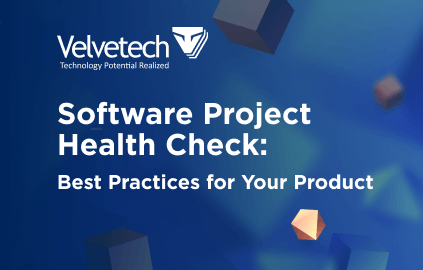In recent years, the popularity of cloud-based solutions has grown significantly and, along with it, the size of the platform as a service (PaaS) market. In fact, revenues within this segment are projected to reach $133.3 billion in 2023 and continue growing at a CAGR of 16.74% until 2027. So, what is all the fuss about? Today, that’s what we are going to explore.
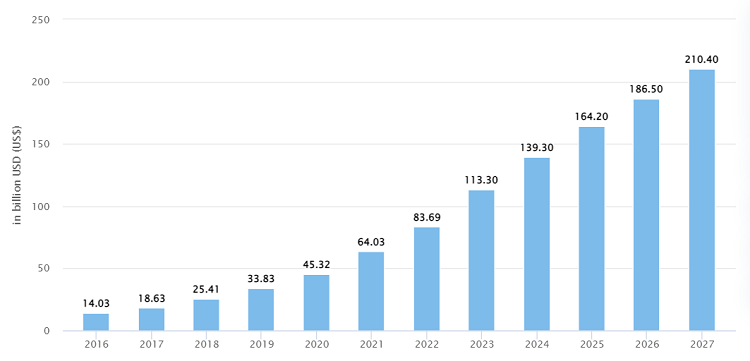
Velvetech’s team has long specialized in the delivery of cloud-based solutions including SaaS platforms, PaaS systems, and the like. So, we want to share our expertise and help you understand what PaaS technology is, the benefits it delivers, and the nuances that are worth keeping in mind before you start building a new product.
Let’s take a look.
What is a Platform as a Service?
PaaS is a cloud computing model that functions as an agile alternative to on-premise solutions. In essence, it is software that can be customized in the cloud and be used as a basis for further development of applications. PaaS simplifies the development and management of IT solutions and is typically provided to end-users on a pay-as-you-go subscription pricing.
Generally speaking, there are three main types of PaaS solutions:
- Public. Likely the most affordable option. It is hosted on a public cloud and multiple enterprises might be using the same platform, albeit via separate accounts.
- Private. Offers the opportunity to customize the cloud environment and for the business to rely on its own hardware for more privacy and data security. Typically more expensive but great for companies that want their own solution.
- Hybrid. Blends public and private PaaS and allows the company to decide which resources should be available via the public version and which should be secured inside the private one. The two are typically connected by proprietary technology that allows for smooth data portability.
Examples of PaaS
Of course, it’s hard to provide examples of private PaaS as many companies naturally prefer to keep their IT strategies quiet. However, these are some of the most popular examples of public platforms as a service:
- Microsoft Azure App Services
- Google App Engine
- IBM Cloud
Velvetech’s team has also worked on various PaaS projects across a range of industries, and we can share a few examples with you.
Logistics
One of the initiatives we recently worked on was within the logistics and transportation sector. There, our team developed a web-based PaaS product that helped manage warehouse operations and provided thorough control over shipments and various inventory processes.
FinTech
Another exciting project was in an entirely different business sector — financial services. We had the pleasure of working with Supervest and helping them develop a platform for alternative investment management that connects accredited investors with merchants that seek loans.
The final product had to have various portals for the different end users including investors, partners, and system administrators. So, we relied on our PaaS specialists to create a platform that would cater to the needs of all three.
Keep reading about Velvetech’s Investment Management App Project
Healthcare
The medical sector is one of Velvetech’s areas of specialty. Hence, we were glad to work with MedAdept on post-acute care coordination platform development. As a result of the collaboration, the Client acquired a solution that helps clinics, hospitals, and post-acute providers deliver efficient care services.
So, as you can see. PaaS solutions are present across a range of industries. They can help logistics firms just as well as financial organizations.
SaaS vs. PaaS vs. IaaS
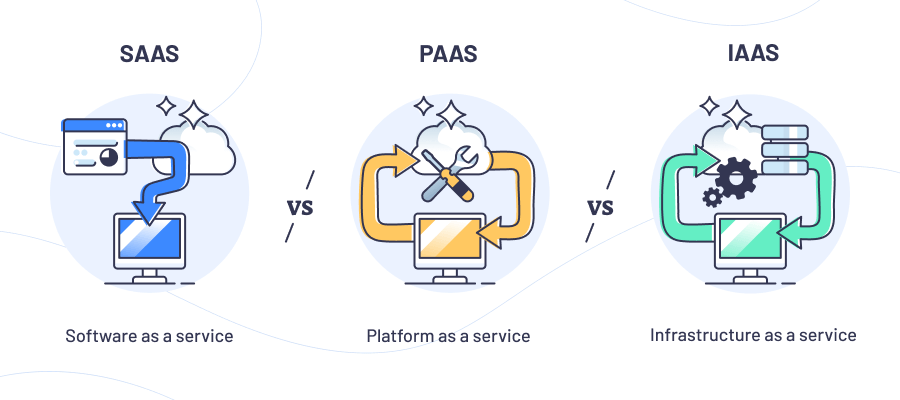
Before we continue discussing PaaS in more detail, let’s first establish what is the difference between the three most well-known cloud service offerings – SaaS, PaaS, and IaaS.
We’ve already covered SaaS architecture basics in our blog and discussed how businesses can build their own SaaS products, but let’s quickly recap. SaaS is essentially a ready-made software that is provided over the cloud to end users, allowing them to immediately start using a third-party solution without developing their own from scratch.
PaaS, on the other hand, offers more functionality by providing a wide range of customization options, as you have seen from our definition above.
So, the main difference between PaaS and SaaS is that the former offers a more comprehensive set of services and tools, while the latter offers pre-built applications that are ready to use and may only offer minor customization. PaaS requires developers to set up, deploy, and support applications, while SaaS provides ready-made apps that can be leveraged immediately.
Platforms, like the Creatio CRM, fall under the PaaS category since they offer vast customization opportunities. For example, the ability to design business processes and develop add-ons.
Finally, you may have also heard of the term IaaS. This stands for infrastructure as a service and essentially means that the provider offers end-users the opportunity to access cloud-based computing infrastructure like servers, storage, and networks.
Project Health Check
Learn the actionable steps to keep your software project on the right track, aligned with your initial goals and designated priorities.
Platform as a Service Benefits
Now, let’s talk a little about end users and why they might be interested in this kind of a solution. Whether you’re curious to implement PaaS for your own business or rather thinking about developing one and offering it as a product to end users, it’s worth knowing the advantages of these systems.
Here, it’s important to note that when we say “end users of PaaS” we mean employees in companies or entire departments that will use the platform to set up business processes, customize system functionality, all with the goal of supporting operations.
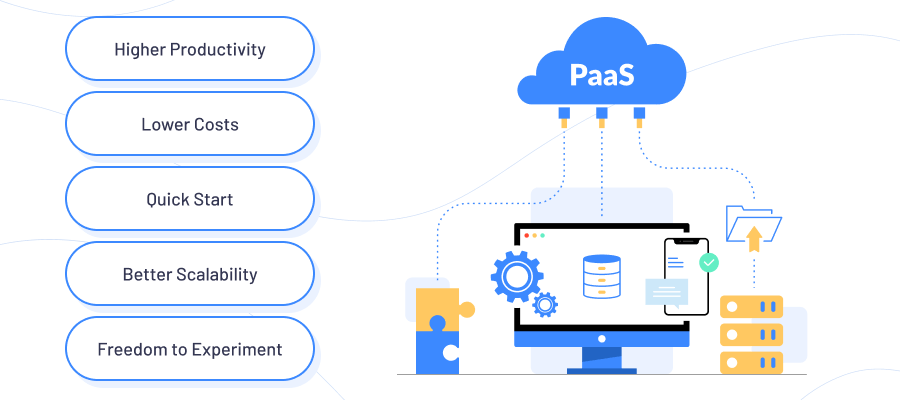
Higher Productivity
With PaaS software end users don’t have to spend ample amounts of time on development of workflow logic or customization of the platform. Everything is seamless and easy which gives a nice productivity boost when compared to coding from scratch or hiring in-house IT specialists to deal with it all.
Reduced Costs
We have now established that PaaS architecture is centered around the cloud. So, it doesn’t require hardware purchasing or paying for custom on-premise deployment. Instead, you make regular monthly or yearly payments which typically, albeit not always, amount to less than if you were to manage everything yourself.
Quick Start
By leveraging PaaS you can start using the solution a lot quicker. After all, there is no longer a need to spend a lot of time on development. Since solutions typically come with in-built code libraries, debugging tools, and databases, they eliminate routine developer tasks and automate application building or customization.
Better Scalability
It is hard to scale on-premise platforms as they are constrained by existing hardware, network capabilities, and so on. With PaaS, on the other hand, you can simply purchase additional capacity and start leveraging it instantaneously. Thus, reducing the amount of hassle involved in scaling your solution.
Freedom to Experiment
Lastly, experimentation becomes less scary with PaaS because these platforms make it possible to try out certain codes, languages, and operating systems without a big upfront investment.
As a quick side note, there are also various advantages of PaaS for businesses that choose to develop them. Specifically, as a PaaS product owner, you’ll benefit from:
- Predictable revenue
- Lower customer acquisition costs
- Higher levels of retention
- Data-based insights for product improvement
PaaS Limitations
While PaaS does offer various advantages, there are also a few challenges with this technology that warrant your attention. Of course, these limitations are unlikely to deter deployment but they are definitely worth keeping in mind and planning for.
- Cybersecurity. Whenever you work with the cloud, it’s common to worry about the safety of digital information since it is transferred over the Internet and stored on external servers. To tackle this challenge, make sure to only work with partners who have a good track record of ensuring security.
- Compatibility. A PaaS solution needs to fit into the existing IT infrastructure and work with existing systems. Hence, it might take some time to integrate all the platforms together and make sure they work smoothly. To deal with this, it’s worth thinking about all of the software that will need to be connected to the PaaS solution prior to starting development and implementation.
- Regulatory compliance. Depending on the industry, your company may be constrained by data-related regulations that you need to adhere to. In this case, don’t forget to build the PaaS solution in a way that takes these laws into account and doesn’t put you or your end users under any risk of non-compliance.
These aren’t the only challenges you’ll face on your PaaS journey, but these are some of the most common concerns we hear from our Clients. So, don’t forget to discuss these points during your project meetings.
Common PaaS Use Cases
Having covered the advantages and limitations of PaaS, let’s now discuss the contexts within which these platforms are typically used.
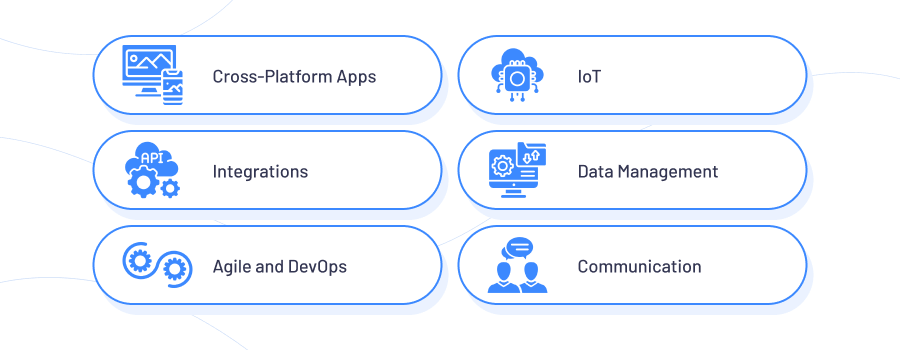
Cross-Platform Apps
PaaS solutions are often used in cross-platform projects. This is because they facilitate work within a single environment to create an app that will work across a variety of devices instead of having to rely on different platform-specific frameworks.
Overall, PaaS technology is very useful in mobile app development as it can significantly speed up the process of building the final solution. With simple, low-code features like the drag-and-drop, creating mobile tools that fit requirements becomes a lot easier.
Find out how we developed an M-Learning Framework for Educational Apps
Integrations
PaaS platforms are also great with API development and management as they help integrate data across organizational apps. Simply put, thanks to built-in frameworks within PaaS solutions, it becomes easy to develop, run, and manage APIs.
Internet of Things
PaaS plays a major role in the Internet of Things due to the fact that it can make it easier to manage the storage and filtering of real-time data created by IoT devices. All in all, PaaS solutions facilitate connectivity and integrations that are so crucial in IoT projects by supporting multiple relevant programming languages and app environments.
Read about our Award-Winning IoT Product Development Project
Data Management
Businesses also tend to use PaaS for data management. Why? Well, once again, these platforms offer easy-to-use features that help manage digital information, organize databases, and maintain well-running data processes. So, definitely don’t underestimate the power of a platform as a service for your enterprise’s information flows.
Discover Cloud Data Management Best Practices
Agile and DevOps
Another interesting use of PaaS is in agile development and DevOps. You see, some platform as a service solutions can deliver extensive environments for automating app lifecycles. Specifically, they can facilitate the integration, testing, and deployment of software.
Communication
Finally, some PaaS software helps app creators implement communications services like audio or video calls, chats, or social media into the final solution. All without forcing them to build a proper real-time communications infrastructure.
Need Help With PaaS?
We know it can be difficult to evaluate whether or not PaaS solutions might be of interest to your business. So, we hope this article has clarified a few things. However, if you want a personalized assessment of PaaS suitability for your unique needs, feel free to chat with our specialists.
Velvetech’s team is proud to offer an extensive range of SaaS development services, and as such, we’d be happy to discuss your next cloud-based project. We cater to companies from a range of industries with a variety of different goals. Some are keen to develop digital products and offer them to end users, while others are looking for software to optimize internal processes. Whatever the case may be, we have specialists that can help.
So, don’t hesitate to get in touch. We will connect you with the relevant team swiftly.






